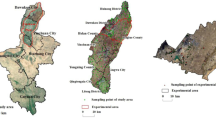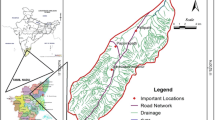Abstract
Snowmelt runoff has a considerable role in water supply in mountainous watershed areas. This study was used to estimate snowmelt runoff by using snowmelt runoff modeling (SRM) in Taleghan watershed, Iran. The SRM is a hydrological model that has been used to estimate daily flow in mountainous watershed areas. This model computes the snowmelt runoff by using meteorological, hydrological parameters and physical characteristics of the basin, and in addition, shows the results as graphs and numerically accompanied with observed amount of runoff. The purpose of this study is to evaluate the degree-day and radiation of the SRM and to also offer the appropriate method for temperature interpolation, which is the principle input of the SRM. Values of these input parameters were defined and model simulation was carried out. The computed and observed hydrographs were plotted. Hydrographs were compared to each other by using visual inspection, the efficiency coefficient of Nash–Sutcliffe (NSE) and difference of volume percent (D v). The NSE value in the validation period was estimated from 0.65 to 0.86 and 0.80 to 0.88 for degree-day and radiation models, respectively. The D v in the validation period was estimated from 1.85 to 18.36 for degree-day model and −0.65 to −4.54 for radiation model. Seven different temperature interpolation methods were performed using degree-day and radiation models of SRM over the Taleghan basin. Results showed that estimation of temperature by different methods can cause differences between estimated and observed runoffs. Also in order to overcome the shortage of measured data in the snowmelt runoff modeling, the temperature interpolation method and adding the radiation factor to the model would greatly help in improving the simulation accuracy and describing the snow-hydrological behaviors in watershed area.







Similar content being viewed by others
References
Biggs TW, Whitaker TM (2012) Critical elevation zones of snowmelt during peak discharges in a mountain river basin. J Hydrol 438:52–65
Brubaker K, Rango A, Kustas W (1996) Incorporating radiation inputs into the snowmelt runoff model. Hydrol Process 10(10):1329–1343
Butt MJ, Bilal M (2011) Application of snowmelt runoff model for water resource management. Hydrol Process 25(24):3735–3747
Cline D, Elder K, Bales R (1998) Scale effects in a distributed snow water equivalence and snowmelt model for mountain basins. Hydrol Process 12(10–11):1527–1536
de la Paix MJ, Lanhai L, Jiwen G, de Dieu HJ, Theoneste N (2012) Analysis of snowmelt model for flood forecast for water in arid zone: case of Tarim River in Northwest China. Environ Earth Sci 66(5):1423–1429
Debele B, Srinivasan R, Gosain A (2010) Comparison of process-based and temperature-index snowmelt modeling in SWAT. Water Resour Manag 24(6):1065–1088
DeWalle DR, Rango A (2008) Principles of Snow Hydrology, First edn, Cambridge University Press
Dey B, Sharma V, Rango A (1989) A test of snowmelt-runoff model for a major river basin in western Himalayas. Nord Hydrol 20(3):167–178
Dou Y, Chen X, Bao A, Li L (2011) The simulation of snowmelt runoff in the ungauged Kaidu river basin of TianShan mountains, China. Environ Earth Sci 62(5):1039–1045
Dunn S, Colohan R (1999) Developing the snow component of a distributed hydrological model: a step-wise approach based on multi-objective analysis. J Hydrol 223(1):1–16
Garen DC, Marks D (2005) Spatially distributed energy balance snowmelt modelling in a mountainous river basin: estimation of meteorological inputs and verification of model results. J Hydrol 315(1):126–153
Gómez-Landesa E, Rango A (2002) Operational snowmelt runoff forecasting in the Spanish Pyrenees using the snowmelt runoff model. Hydrol Process 16(8):1583–1591
Hall DK, Riggs GA, Salomonson VV, Digirolamo NE, Bayr KJ (2002) MODIS snow-cover products. Remote Sens Environ 83(1):181–194
Hancock S, Baxter R, Evans J, Huntley B (2013) Evaluating global snow water equivalent products for testing land surface models. Remote Sens Environ 128:107–117
Harshburger BJ, Humes KS, Walden VP, Moore BC, Blandford TR, Rango A (2010) Evaluation of short to medium range streamflow forecasts obtained using an enhanced version of SRM. J Am Water Resour Assoc 46(3):603–617
Hock R (1999) A distributed temperature-index ice-and snowmelt model including potential direct solar radiation. J Glaciol 45(149):101–111
Hock R (2003) Temperature index melt modelling in mountain areas. J Hydrol 282(1):104–115
Homan JW, Luce CH, Mcnamara JP, Glenn NF (2011) Improvement of distributed snowmelt energy balance modeling with MODIS based NDSI derived fractional snow-covered area data. Hydrol Process 25(4):650–660
Johnston K, VerHoef JM, Krivoruchko K, Lucas N (2001) Using ArcGIS Geostatistical Analyst-GIS by ESRI, United States of America by ESRI, USA
Li X, Williams MW (2008) Snowmelt runoff modelling in an arid mountain watershed, Tarim basin, China. Hydrol Process 22(19):3931–3940
Lindström G, Johansson B, Persson M, Gardelin M, Bergström S (1997) Development and test of the distributed HBV-96 hydrological model. J Hydrol 201(1):272–288
Ma H, Cheng G (2003) A test of snowmelt runoff model (SRM) for the Gongnaisi river basin in the western Tianshan mountains, China. Chin Sci Bull 48(20):2253–2259
Mandal AK, Zhang J (2012) Climate change and the future of freshwater resources of the island: a case study on the Rishiri Island, Japan. Environ Earth Sci 66(5):1309–1319
Martinec J (1975) Snowmelt-runoff model for stream flow forecasts. Nord Hydrol 6(3):145–154
Martinec J (1985) Snowmelt runoff models for operational forecasts. Nord Hydrol 16(3):129–136
Martinec J, Rango A, Roberts R (2008) Snowmelt runoff model (SRM) user’s manual. In: Baumgartner MF, Apfl GM (eds) USDA Jornada Experimental Range, New Mexico State University, Las Cruces, NM, USA, p 177
Noor H, Vafakhah M, Taheriyoun M, Moghadasi M (2014) Hydrology modelling in Taleghan mountainous watershed using SWAT. J Water Land Dev 20(1):11–18
Rango A, Katwijk V (1990) Development and testing of a snowmelt-runoff forecasting technique. J Am Water Resour Assoc 26(1):135–144
Rango A, Martinec J (1995) Revisiting the degree-day method for snowmelt computations. J Am Water Resour Assoc 31(4):657–669
Schaper J, Martinec J, Seidel K (1999) Distributed mapping of snow and glaciers for improved runoff modelling. Hydrol Process 13:2023–2031
Singh P, Kumar N, Arora M (2000) Degree-day factors for snow and ice for Dokriani Glacier, Garhwal Himalayas. J Hydrol 235(1):1–11
Steele C, Rango A, Hall D, Bleiweiss M (2010) Sensitivity of the snowmelt runoff model to underestimates of remotely sensed snow covered area. Geoscience and Remote Sensing Symposium (IGARSS), 2010 IEEE International, pp 2382–2385
Stroeve JC, Box JE, Haran T (2006) Evaluation of the MODIS daily snow albedo product over the Greenland ice sheet. Remote Sens Environ 105(2):155–171
Tahir AA, Chevallier P, Arnaud Y, Neppel L, Ahmad B (2011) Modeling snowmelt-runoff under climate scenarios in the Hunza river basin, Karakoram range, northern Pakistan. J Hydrol 409(1):104–117
Tekeli AE, Akyürek Z, ArdaŞorman A, Şensoy A, ÜnalŞorman A (2005) Using MODIS snow cover maps in modeling snowmelt runoff process in the eastern part of Turkey. Remote Sens Environ 97(2):216–230
Vafakhah M, Saravi MM (2011) Optimizing management of soil erosion in Orazan sub-basin, Iran. J Agric Sci Technol 13(5):717–726
Wang J, Li W (2001) Establishing snowmelt runoff simulating model using remote sensing data and GIS in the west of China. Int J Remote Sens 22(17):3267–3274
Zeng C, Gremaud V, Zeng H, Liu Z, Goldscheider N (2012) Temperature-driven meltwater production and hydrochemical variations at a glaciated alpine karst aquifer: implication for the atmospheric CO2 sink under global warming. Environ Earth Sci 65:2285–2297
Zhang Y, Zhang S, Xia J, Hua D (2013) Temporal and spatial variation of the main water balance components in the three rivers source region, China from 1960 to 2000. Environ Earth Sci 68(4):973–983
Zhao Q, Ye B, Ding Y, Zhang S, Yi S, Wang J, Shangguan D, Zhao C, Han H (2013) Coupling a glacier melt model to the Variable Infiltration Capacity (VIC) model for hydrological modeling in north-western China. Environ Earth Sci 68(1):87–101
Zillman JW (1972) A study of some aspects of the radiation and heat budgets of the southern hemisphere oceans, M.Sc. Thesis, Department of the Interior, University of Melbourne, Canberra, Australian Government Publishing Service, p 562
Author information
Authors and Affiliations
Corresponding author
Rights and permissions
About this article
Cite this article
Vafakhah, M., Nouri, A. & Alavipanah, S.K. Snowmelt-runoff estimation using radiation SRM model in Taleghan watershed. Environ Earth Sci 73, 993–1003 (2015). https://doi.org/10.1007/s12665-014-3449-5
Received:
Accepted:
Published:
Issue Date:
DOI: https://doi.org/10.1007/s12665-014-3449-5




